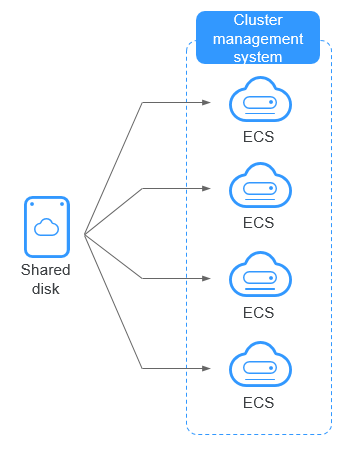Disk Sharing¶
What Is Disk Sharing?¶
Disk sharing allows you to create shared EVS disks. Shared EVS disks are block storage devices that support concurrent read/write operations and can be attached to multiple servers. Shared EVS disks provide multiple attachments, high concurrency, high performance, and high reliability. They are usually used for enterprise business-critical applications that require cluster deployment and high availability (HA). Multiple servers can access the same shared EVS disk at the same time.
A shared EVS disk can be attached to a maximum of 16 servers, including ECSs or BMSs. To share files, you need to deploy a shared file system or a cluster management system, such as Windows MSCS, Veritas VCS, or CFS.
Important
A shared file system or cluster management system must be set up before you can properly use a shared disk. If you simply attach a shared disk to multiple servers, data cannot be shared between those servers and may be overwritten.

Figure 1 Application scenario of shared EVS disks¶
Advantages¶
Multiple attachments: A shared EVS disk can be attached to a maximum of 16 servers.
High-performance: The random read/write IOPS of a shared ultra-high I/O disk can reach up to 160,000.
High-reliability: Shared EVS disks support both manual and automatic backup, delivering highly reliable data storage.
Wide range of use: Shared EVS disks can be used for Linux RHCS clusters where only shared VBD disks are needed. They can also be used for Windows MSCS and Veritas VCS clusters that require SCSI reservations.
Specifications and Performance¶
Shared EVS disks have the same specifications and performance as non-shared EVS disks.
Data Sharing Principles and Common Usage Mistakes¶
A shared EVS disk is essentially the disk that can be attached to multiple servers for use. It is similar to a physical disk in that the disk can be attached to multiple physical servers, and each server can read data from and write data to any space on the disk. If no data read/write rules, such as the read/write sequence and meaning, between these servers are defined, data reads and writes between these servers may conflict, or other unpredictable errors may occur.
Though shared EVS disks are block storage devices that provide shared access for servers, shared EVS disks do not have the cluster management capability. You need to deploy a cluster system to manage shared EVS disks. Common cluster management systems include Windows MSCS, Linux RHCS, Veritas VCS, and Veritas CFS.
If shared EVS disks are not managed by a cluster system, the following issues may occur:
Data inconsistency caused by read/write conflicts
When a shared EVS disk is attached to two servers (server A and server B), server A cannot recognize the disk spaces allocated to server B, vice versa. That said, a disk space allocated to server A may be already used by server B. In this case, repeated disk space allocation occurs, which leads to data errors.
For example, a shared EVS disk has been formatted into an ext3 file system and attached to server A and server B. Server A has written metadata into the file system in space R and space G. Then server B has written metadata into space E and space G. In this case, the data written into space G by server A will be replaced. When the metadata in space G is read, an error will occur.
Data inconsistency caused by data caching
When a shared EVS disk is attached to two servers (server A and server B), the application on server A has read the data in space R and space G, then cached the data. At that time, other processes and threads on server A would then read this data directly from the cache. At the same time, if the application on server B has modified the data in space R and space G, the application on server A cannot detect this data change and still reads this data from the cache. As a result, the modified data cannot be viewed on server A.
For example, a shared EVS disk has been formatted into an ext3 file system and attached to server A and server B. Both servers have cached the metadata in the file system. Then server A has created a new file (file F) on the shared disk, but server B cannot detect this modification and still reads data from its cached data. As a result, file F cannot be viewed on server B.
Before you buy a shared EVS disk, determine its device type (VBD or SCSI) based on the applications that will use the shared disk. Shared SCSI EVS disks support SCSI reservations. Before using SCSI reservations, you need to install a driver in the server OS and ensure that the OS image is included in the compatibility list.
For details about how to use shared EVS disks, see Managing Shared EVS Disks.
Important
If you simply attach a shared disk to multiple servers, data or files cannot be shared between the servers, because the shared disk does not have the cluster management capability. To share files between servers, build a shared file system or deploy a cluster management system.